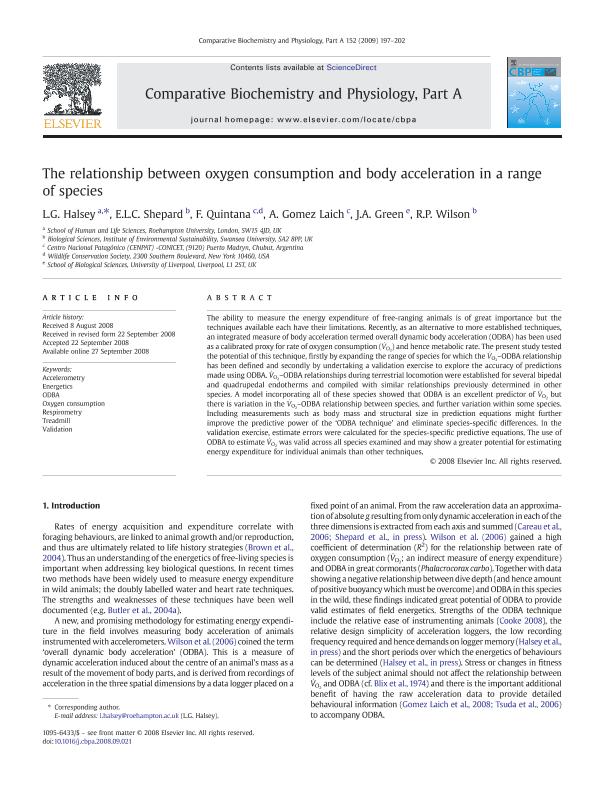Mostrar el registro sencillo del ítem
dc.contributor.author
Halsey, L. G.
dc.contributor.author
Shepard, E. L. C.
dc.contributor.author
Quintana, Flavio Roberto

dc.contributor.author
Gómez Laich, Agustina Marta

dc.contributor.author
Green, J. A.
dc.contributor.author
Wilson, Rory P.

dc.date.available
2020-02-10T19:00:34Z
dc.date.issued
2009-02
dc.identifier.citation
Halsey, L. G.; Shepard, E. L. C.; Quintana, Flavio Roberto; Gómez Laich, Agustina Marta; Green, J. A.; et al.; The relationship between oxygen consumption and body acceleration in a range of species; Elsevier Science Inc; Comparative Biochemistry and Physiology Part A: Molecular and Integrative Physiology; 152; 2; 2-2009; 197-202
dc.identifier.issn
1095-6433
dc.identifier.uri
http://hdl.handle.net/11336/97083
dc.description.abstract
The ability to measure the energy expenditure of free-ranging animals is of great importance but the techniques available each have their limitations. Recently, as an alternative to more established techniques, an integrated measure of body acceleration termed overall dynamic body acceleration (ODBA) has been used as a calibrated proxy for rate of oxygen consumption (V̇O2) and hence metabolic rate. The present study tested the potential of this technique, firstly by expanding the range of species for which the V̇O2-ODBA relationship has been defined and secondly by undertaking a validation exercise to explore the accuracy of predictions made using ODBA. V̇O2-ODBA relationships during terrestrial locomotion were established for several bipedal and quadrupedal endotherms and compiled with similar relationships previously determined in other species. A model incorporating all of these species showed that ODBA is an excellent predictor of V̇O2 but there is variation in the V̇O2-ODBA relationship between species, and further variation within some species. Including measurements such as body mass and structural size in prediction equations might further improve the predictive power of the 'ODBA technique' and eliminate species-specific differences. In the validation exercise, estimate errors were calculated for the species-specific predictive equations. The use of ODBA to estimate V̇O2 was valid across all species examined and may show a greater potential for estimating energy expenditure for individual animals than other techniques.
dc.format
application/pdf
dc.language.iso
eng
dc.publisher
Elsevier Science Inc

dc.rights
info:eu-repo/semantics/openAccess
dc.rights.uri
https://creativecommons.org/licenses/by-nc-nd/2.5/ar/
dc.subject
ACCELEROMETRY
dc.subject
ENERGETICS
dc.subject
ODBA
dc.subject
OXYGEN CONSUMPTION
dc.subject
RESPIROMETRY
dc.subject
TREADMILL
dc.subject
VALIDATION
dc.subject.classification
Ecología

dc.subject.classification
Ciencias Biológicas

dc.subject.classification
CIENCIAS NATURALES Y EXACTAS

dc.title
The relationship between oxygen consumption and body acceleration in a range of species
dc.type
info:eu-repo/semantics/article
dc.type
info:ar-repo/semantics/artículo
dc.type
info:eu-repo/semantics/publishedVersion
dc.date.updated
2019-12-12T14:46:25Z
dc.journal.volume
152
dc.journal.number
2
dc.journal.pagination
197-202
dc.journal.pais
Estados Unidos

dc.description.fil
Fil: Halsey, L. G.. Roehampton University; Reino Unido
dc.description.fil
Fil: Shepard, E. L. C.. Swansea University; Reino Unido
dc.description.fil
Fil: Quintana, Flavio Roberto. Consejo Nacional de Investigaciones Científicas y Técnicas. Centro Científico Tecnológico Conicet - Centro Nacional Patagónico; Argentina. Wildlife Conservation Society; Estados Unidos
dc.description.fil
Fil: Gómez Laich, Agustina Marta. Consejo Nacional de Investigaciones Científicas y Técnicas. Centro Científico Tecnológico Conicet - Centro Nacional Patagónico; Argentina
dc.description.fil
Fil: Green, J. A.. University of Liverpool; Reino Unido
dc.description.fil
Fil: Wilson, Rory P.. Swansea University; Reino Unido
dc.journal.title
Comparative Biochemistry and Physiology Part A: Molecular and Integrative Physiology

dc.relation.alternativeid
info:eu-repo/semantics/altIdentifier/doi/http://dx.doi.org/10.1016/j.cbpa.2008.09.021
dc.relation.alternativeid
info:eu-repo/semantics/altIdentifier/url/https://www.sciencedirect.com/science/article/pii/S1095643308011513
Archivos asociados
